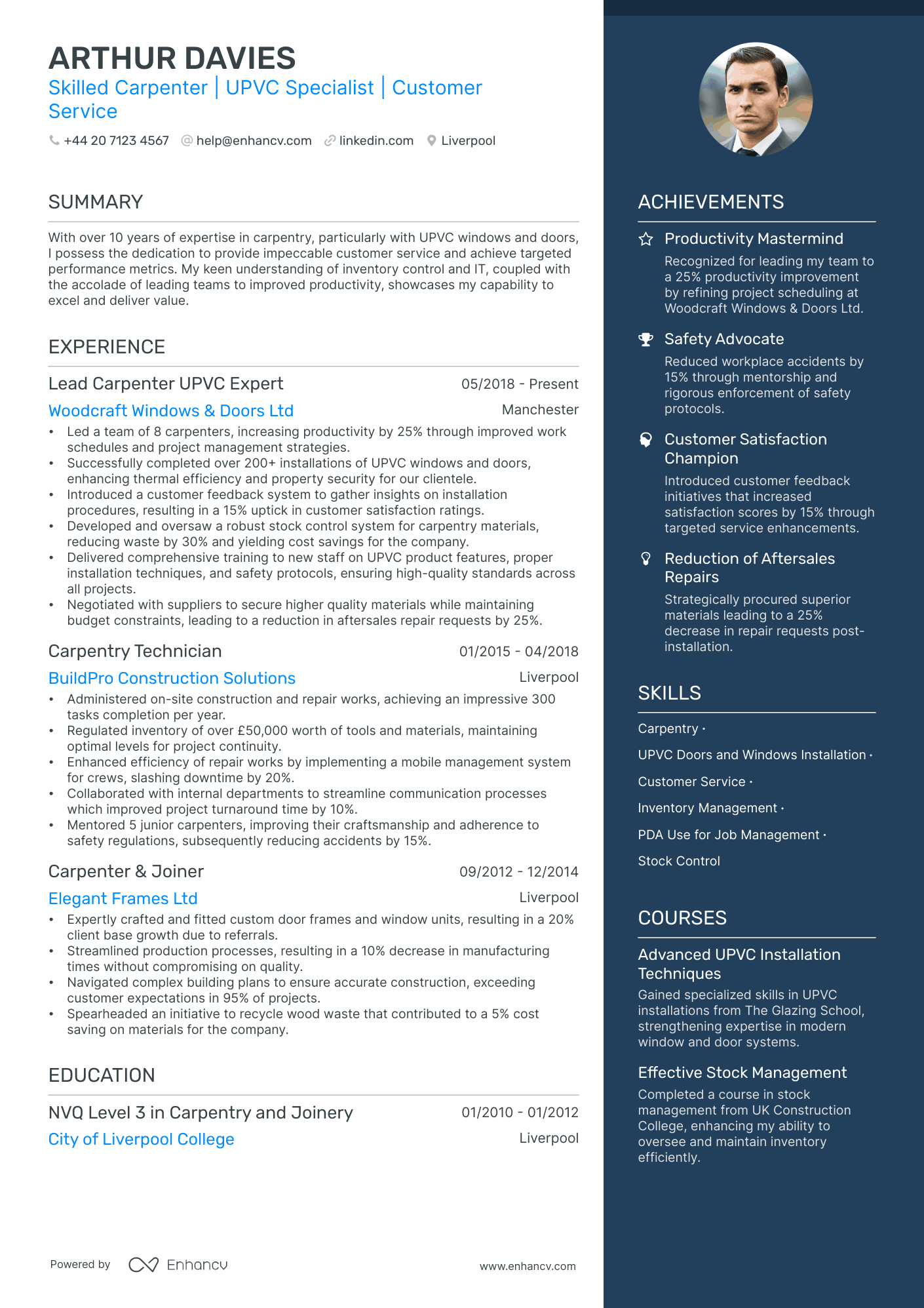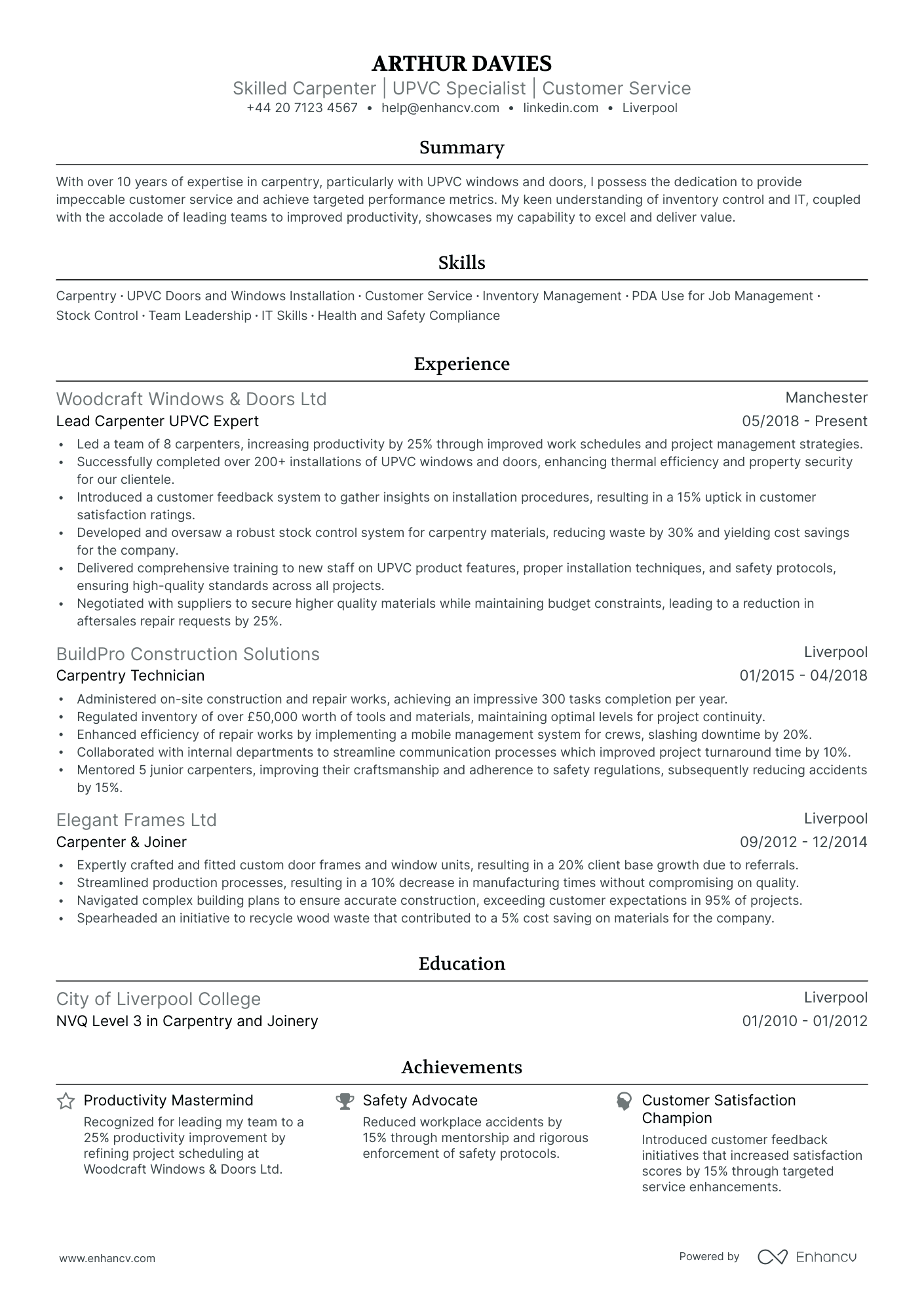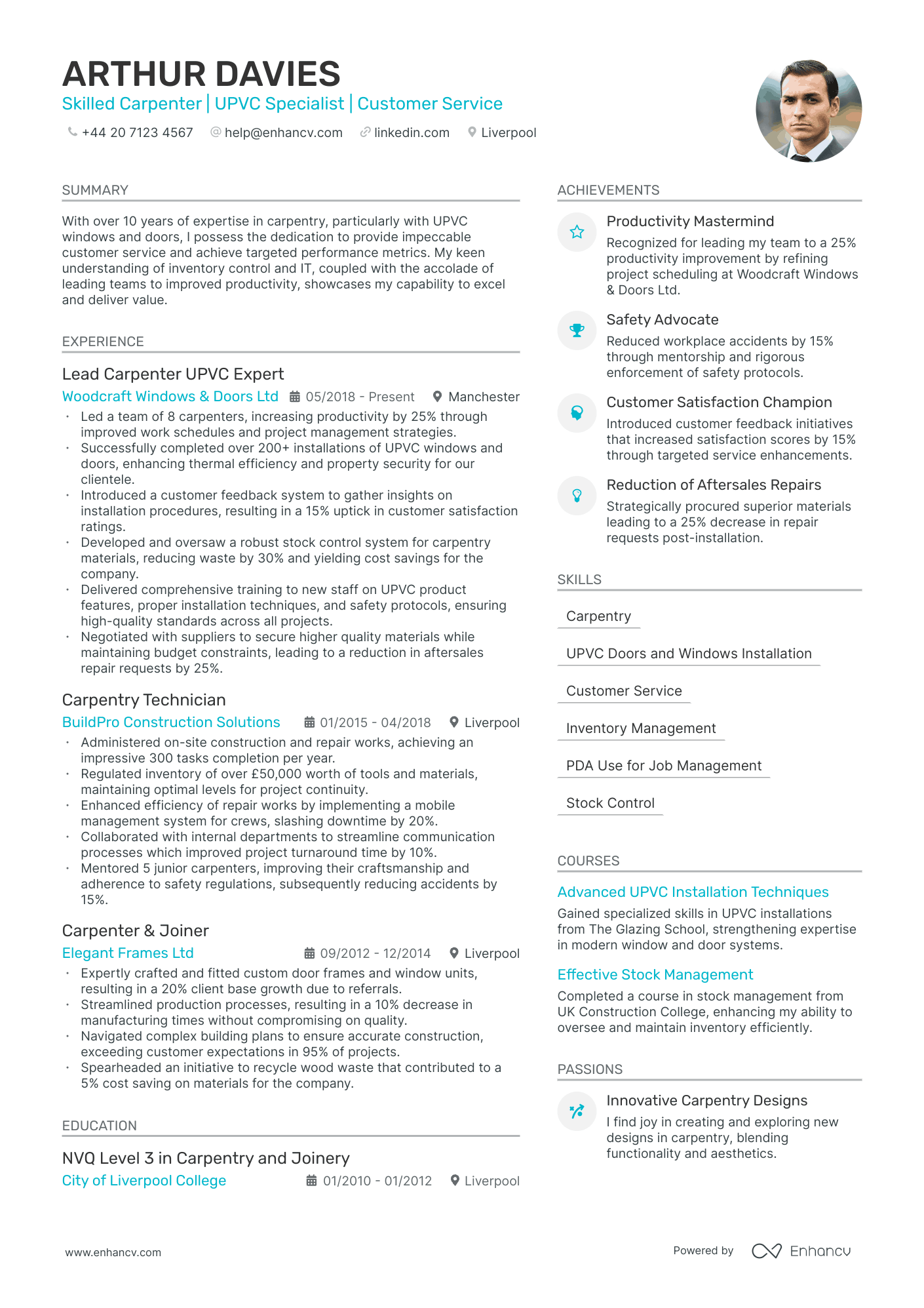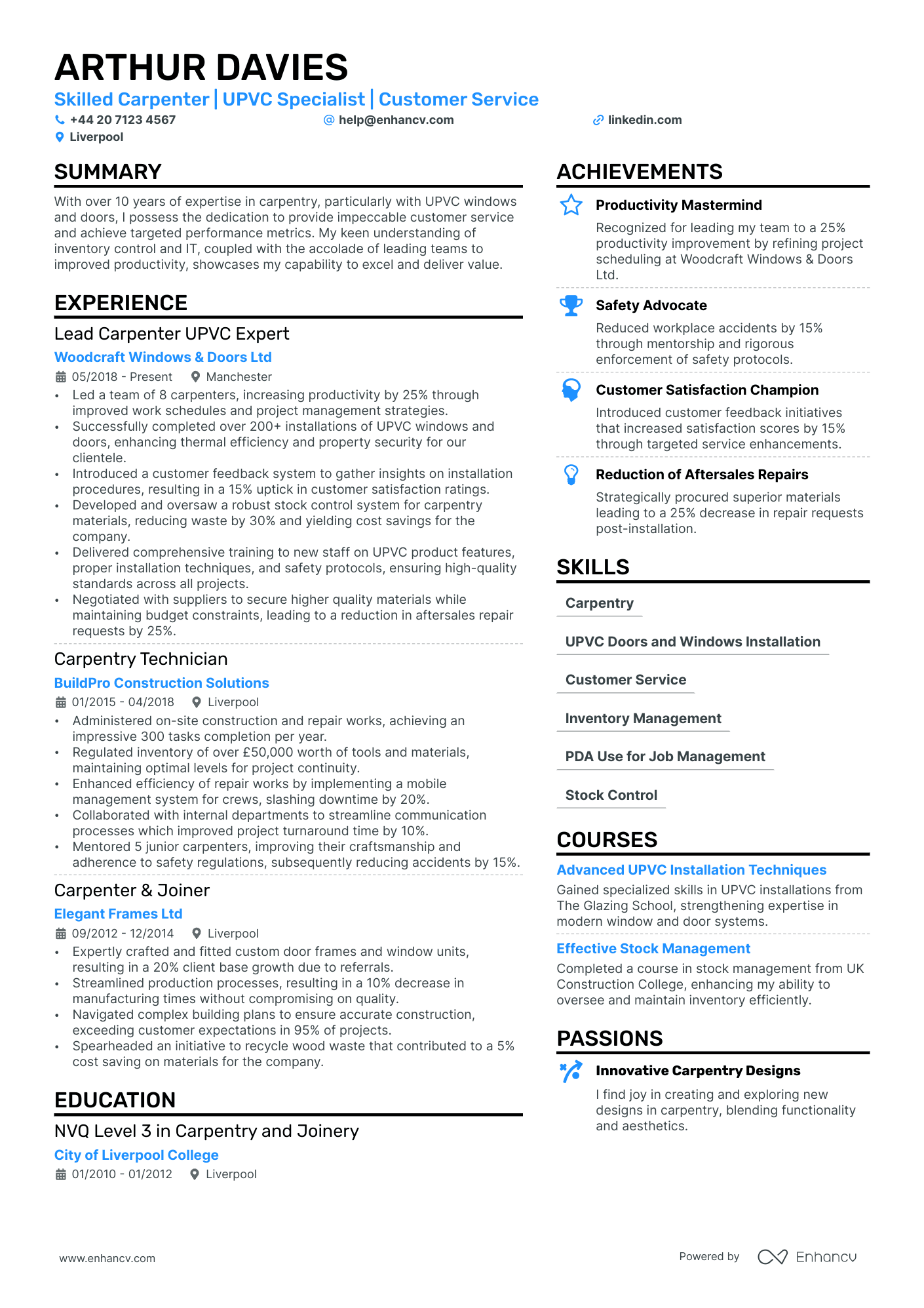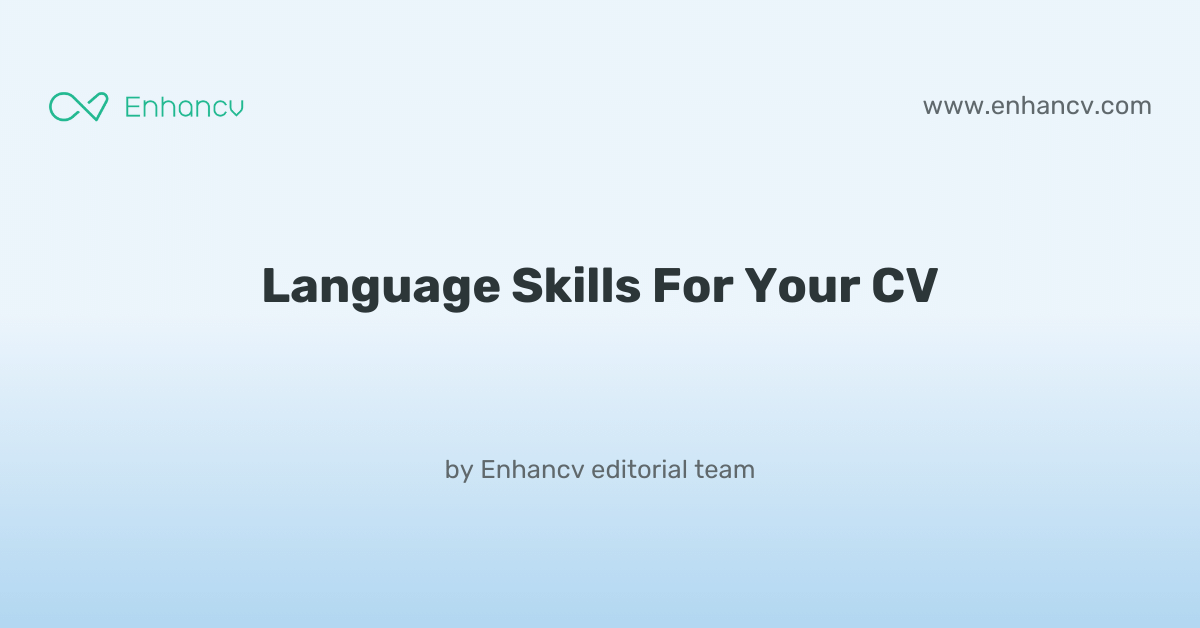Identifying the most relevant skills and experiences to include can be a daunting CV challenge for a carpenter, given the wide range of projects you may have worked on. Our guide offers tailored advice to help you meticulously craft a summary of your qualifications that will resonate with potential employers in the construction industry.
- Design and format your professional carpenter CV;
- Curate your key contact information, skills, and achievements throughout your CV sections;
- Ensure your profile stays competitive by studying other industry-leading carpenter CVs;
- Create a great CV even if you happen to have less professional experience, or switching fields.
When writing your carpenter CV, you may need plenty of insights from hiring managers. We have prepared industry-leading advice in the form of our relevant CV guides.
How to ensure your profile stands out with your carpenter CV format
It's sort of a Catch 22. You want your carpenter CV to stand out amongst a pile of candidate profiles, yet you don't want it to be too over the top that it's unreadable. Where is the perfect balance between your CV format simple, while using it to shift the focus to what matters most. That is - your expertise. When creating your carpenter CV:- list your experience in the reverse chronological order - starting with your latest roles;
- include a header with your professional contact information and - optionally - your photograph;
- organise vital and relevant CV sections - e.g. your experience, skills, summary/ objective, education - closer to the top;
- use no more than two pages to illustrate your professional expertise;
- format your information using plenty of white space and standard (2.54 cm) margins, with colours to accent key information.
Once you've completed your information, export your carpenter CV in PDF, as this format is more likely to stay intact when read by the Applicant Tracker System or the ATS. A few words of advice about the ATS - or the software used to assess your profile:
- Generic fonts, e.g. Arial and Times New Roman, are ATS-compliant, yet many candidates stick with these safe choices. Ensure your CV stands out by using a more modern, and simple, fonts like Lato, Exo 2, Volkhov;
- All serif and sans-serif fonts are ATS-friendly. Avoid the likes of fancy decorative or script typography, as this may render your information to be illegible;
- Both single- and double-column formatted CVs could be assessed by the ATS;
- Integrating simple infographics, icons, and charts across your CV won't hurt your chances during the ATS assessment.
PRO TIP
For certain fields, consider including infographics or visual elements to represent skills or achievements, but ensure they are simple, professional, and enhance rather than clutter the information.
The top sections on a carpenter CV
- Personal Profile highlights your professional identity as carpenters need to showcase reliability and skill.
- Key Skills display woodworking techniques and tool proficiency relevant to a carpenter's expertise.
- Professional Experience details past carpentry projects and roles, displaying hands-on experience.
- Education and Training indicate formal qualifications and carpentry certifications necessary for the trade.
- References provide credibility through previous employers vouching for your carpentry skills and work ethic.
What recruiters value on your CV:
- Highlight your hands-on experience with various carpentry tasks, such as framing, roofing, and finishing work, ensuring you mention specific projects and the range of skills you applied.
- Detail any carpentry qualifications or certifications you possess, such as a City & Guilds or NVQ qualification, to immediately show your expertise and commitment to the trade.
- Provide examples of specialised carpentry skills, like custom furniture making or heritage restoration work, to showcase niche expertise that sets you apart from other candidates.
- Emphasise your proficiency with a wide array of carpentry tools and machinery, from hand tools to power saws, underpinning your versatility and technical knowledge.
- Include evidence of your ability to read and interpret blueprints and architectural drawings, as this skill is vital for ensuring accurate construction and demonstrating your industry savvy.
Recommended reads:
What information should you include in your carpenter CV header?
The CV header is potentially the section that recruiters would refer to the most, as it should include your:
- Contact details - your professional (non-work) email address and phone number;
- Professional photograph - if you're applying hinting at the value you bring as a professional.
Many professionals often struggle with writing their carpenter CV headline. That's why in the next section of this guide, we've curated examples of how you can optimise this space to pass any form of assessment.
Examples of good CV headlines for carpenter:
- Master Carpenter | Expert in Bespoke Furniture | City & Guilds Certified | 20+ Years Experience
- Joinery Specialist | Focused on Eco-Friendly Practices | NVQ Level 3 | 15 Years in Craftsmanship
- Lead Framing Carpenter | Structural Integrity Advocate | CSCS Accredited | Decade of On-Site Excellence
- Custom Cabinetry Craftsperson | Detail-Oriented | Advanced Woodworking Techniques | 8 Years’ Experience
- Residential Carpenter Foreman | Renovation & Restoration Expert | HNC in Building Studies | 12 Years Leading Projects
- Apprentice Carpenter | Keen on Modern Carpentry Tech | Level 2 Diploma in Carpentry | Committed to Skill Growth
Catching recruiters' attention with your carpenter CV summary or objective
Located closer to the top of your CV, both the summary and objective are no more than five sentences long and serve as an introduction to your experience. What is more, you could use either to entice recruiters to read on. Select the:
- Summary, if you happen to have plenty of relevant experience. Feature your most impressive accomplishments and up to three skills that are relevant to the job you're applying for;
- Objective, if you're just starting your career off. Provide your career goals and answer how you see the role you are applying for will match your professional growth.
Judging which one you need to add to your carpenter CV may at times seem difficult. That’s why you need to check out how professionals, with similar to your experience, have written their summary or objective, in the examples below:
CV summaries for a carpenter job:
- With over a decade of experience as a seasoned carpenter, I have adeptly honed my skills in fine woodcraft, intricate joinery, and robust furniture design, leading to my work being showcased in national design expos and earning the “Best Craftsmanship” award at the London Woodwork Festival.
- As an accomplished carpenter with 15 years of experience in crafting bespoke residential and commercial woodwork, I bring an in-depth understanding of architectural blueprints and a talent for creating custom cabinetry that has consistently led to a 30% client referral rate.
- Transitioning from a successful 7-year career in graphic design to carpentry, I offer a unique blend of creative vision and technical woodworking skills, with a strong foundation in 3D modelling and a passion for transforming reclaimed materials into functional art pieces.
- Seeking to leverage 5 years of experience in landscape architecture into carpentry, my proficiency in spatial design and project management, coupled with an enthusiasm for handcrafted textures and sustainable building practices, will enhance the creation of innovative outdoor living spaces.
- Eager to embark on a fulfilling journey in the craft of carpentry, I aim to apply my recent diploma in wood technology, my keen attention to detail, and commitment to quality to master traditional and contemporary woodworking techniques under the guidance of esteemed industry professionals.
- With a newfound respect for the art of carpentry and dedication to learning, my objective is to integrate my strong work ethic, effective problem-solving abilities, and a collaborative attitude to refine my skills and contribute to high-end residential and commercial construction projects.
The best formula for your carpenter CV experience section
The CV experience section is the space where many candidates go wrong by merely listing their work history and duties. Don't do that. Instead, use the job description to better understand what matters most for the role and integrate these keywords across your CV. Thus, you should focus on:
- showcasing your accomplishments to hint that you're results-oriented;
- highlighting your skill set by integrating job keywords, technologies, and transferrable skills in your experience bullets;
- listing your roles in reverse chronological order, starting with the latest and most senior, to hint at how you have grown your career;
- featuring metrics, in the form of percentage, numbers, etc. to make your success more tangible.
When writing each experience bullet, start with a strong, actionable verb, then follow it up with a skill, accomplishment, or metric. Use these professional examples to perfect your CV experience section:
Best practices for your CV's work experience section
- Outlined proficiency in using a variety of power tools such as circular saws, sanders, and nail guns, ensuring adherence to safety protocols and maintenance schedules.
- Highlighted experience in constructing, installing, and repairing structures and fixtures made from wood and other materials, showcasing versatility and craftsmanship.
- Documented ability to read and interpret blueprints, drawings, and sketches to determine specifications and calculate the amount of materials required.
- Demonstrated expertise in selecting appropriate materials, tools, and techniques for all stages of the carpentry process, reflecting a commitment to quality and efficiency.
- Included examples of custom furniture making, providing evidence of attention to detail and the ability to meet client specifications and aesthetic preferences.
- Emphasised proficiency in measuring, cutting, and shaping wood, plastic, fibreglass, or drywall, ensuring projects are completed with precision.
- Mentioned experience with fitting and installing window frames, doors, staircases, and floorboards, displaying a comprehensive skillset.
- Cited instances of collaborating with other construction professionals, such as electricians and plumbers, to ensure the seamless integration of services.
- Noted the application of finishing techniques such as varnishing, staining, and painting, demonstrating a finishing touch that enhances durability and appearance.
- Successfully led a team of 5 carpenters on a complex restoration project for a Grade II listed building, ensuring compliance with heritage preservation standards.
- Implemented a new inventory tracking system for tools and materials which reduced waste by 20% and improved project efficiency.
- Crafted bespoke furniture pieces for over 30 high-end clients, resulting in a 15% increase in customer referrals for the business.
- Designed and executed tailored kitchen fittings for over 25 residential properties, enhancing functionality and aesthetic appeal.
- Collaborated with architects and designers to ensure project specifications were met, resulting in zero defects across all installations.
- Streamlined on-site work processes, cutting project turnaround time by 10% without compromising on quality.
- Played a pivotal role in erecting structural frameworks for 15 new-build apartments, completing tasks 5% ahead of schedule.
- Enhanced safety protocols on-site, contributing to a 25% reduction in accidents and a safer working environment.
- Provided mentorship to apprentice carpenters, improving team skills and the quality of finished work.
- Engineered and installed custom staircases and railings in over 40 multi-storey homes, optimizing for both design and functionality.
- Negotiated with suppliers to secure a 15% discount on timber purchases, directly improving project profit margins.
- Developed a waste reduction program that recycled 60% of offcuts, promoting sustainability and corporate responsibility.
- Specialized in fabricating custom cabinetry, increasing department revenue by 20% through repeat business and client recommendations.
- Coordinated with the installation team to streamline the full-service approach, raising customer satisfaction scores by 30%.
- Adopted new precision woodworking equipment, reducing production times by an average of 10% per project.
- Pioneered an innovative approach to modular building construction, which was adopted company-wide and led to a 15% reduction in labour costs.
- Successfully managed the site carpentry for a 50-unit residential complex, delivering all carpentry work under budget and ahead of schedule.
- Introduced energy-efficient installation methods that contributed to the company receiving the Eco-Builder award in 2016.
- Orchestrated the fit-out carpentry for a prestigious office development, integrating smart storage solutions that saved the client 10% on space planning costs.
- Led a workshop to upskill 20 carpenters in the latest joinery techniques, thereby increasing the quality of craftsmanship and reducing rework by 18%.
- Developed a partnership with a local forestry initiative to source sustainable lumber, positively affecting brand reputation.
- Directed the remodelling of 10 historical residences, incorporating modern amenities while maintaining historical integrity.
- Improved project scheduling by adopting agile methodologies, which reduced delivery times by 12% and increased client satisfaction.
- Facilitated cross-departmental collaboration that resulted in winning the local Chamber of Commerce 'Craftsmanship Award.
Lacking professional expertise: how to write your CV to highlight your best talents
Don't count on your lucky stars when you're applying for a role, where you happen to have less (or almost none) professional experience. Recruiters sometimes do hire inexperienced candidates if they're able to present their unique value from the get-go. So, instead of opting for the traditional, CV experience section:
- List any applicable expertise you happen to have - no matter if it's a part-time job, internship, or volunteer work. This would hint to recruiters that your profile is relevant;
- Focus your CV on your transferrable skills or talents you've obtained thanks to your whole life and work experience. In effect, you'll be spotlighting your value as a candidate;
- Separate more space for your applicable academic background and certificates to show you have the technical know-how;
- Ensure that within your objective, you've defined why you'll like the job and how you'll be the perfect match for it. Always ensure you've tailored your CV to individual applications.
Looking for more good examples for your first job? We'll show you how other candidates, with less professional experience, have created their job-winning CVs.
Recommended reads:
PRO TIP
If you have experience in diverse fields, highlight how this has broadened your perspective and skill set, making you a more versatile candidate.
Describing your unique skill set using both hard skills and soft skills
Your carpenter CV provides you with the perfect opportunity to spotlight your talents, and at the same time - to pass any form of assessment. Focusing on your skill set across different CV sections is the way to go, as this would provide you with an opportunity to quantify your achievements and successes. There's one common, very simple mistake, which candidates tend to make at this stage. Short on time, they tend to hurry and mess up the spelling of some of the key technologies, skills, and keywords. Copy and paste the particular skill directly from the job requirement to your CV to pass the Applicant Tracker System (ATS) assessment. Now, your CV skills are divided into:
- Technical or hard skills, describing your comfort level with technologies (software and hardware). List your aptitude by curating your certifications, on the work success in the experience section, and technical projects. Use the dedicated skills section to provide recruiters with up to twelve technologies, that match the job requirements, and you're capable of using.
- People or soft skills provide you with an excellent background to communicate, work within a team, solve problems. Don't just copy-paste that you're a "leader" or excel at "analysis". Instead, provide tangible metrics that define your success inusing the particular skill within the strengths, achievements, summary/ objective sections.
Top skills for your carpenter CV:
Woodworking
Knowledge of Building Codes
Framing
Finish Carpentry
Cabinet Making
Blueprint Reading
Use of Power and Hand Tools
Construction Mathematics
Material Estimation
Joinery Techniques
Attention to Detail
Problem-Solving
Time Management
Communication
Teamwork
Adaptability
Critical Thinking
Customer Service
Physical Stamina
Reliability
PRO TIP
If you have received professional endorsements or recommendations for certain skills, especially on platforms like LinkedIn, mention these to add credibility.
Your university degree and certificates: an integral part of your carpenter CV
Let's take you back to your uni days and decide what information will be relevant for your carpenter CV. Once more, when discussing your higher education, select only information that is pertinent to the job (e.g. degrees and projects in the same industry, etc.). Ultimately, you should:
- List only your higher education degrees, alongside start and graduation dates, and the university name;
- Include that you obtained a first degree for diplomas that are relevant to the role, and you believe will impress recruiters;
- Showcase relevant coursework, projects, or publications, if you happen to have less experience or will need to fill in gaps in your professional history.
PRO TIP
Focus on describing skills in the context of the outcomes they’ve helped you achieve, linking them directly to tangible results or successes in your career.
Recommended reads:
Key takeaways
Write your professional carpenter CV by studying and understanding what the role expectations are. You should next:
- Focus on tailoring your content to answer specific requirements by integrating advert keywords through various CV sections;
- Balance your technical know-how with your personal skills to showcase what the unique value would be of working with you;
- Ensure your CV grammar and spelling (especially of your key information and contact details) is correct;
- Write a CV summary, if your experience is relevant, and an objective, if your career ambitions are more impressive;
- Use active language by including strong, action verbs across your experience, summary/objective, achievements sections.
